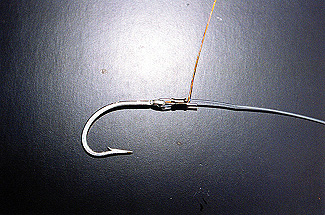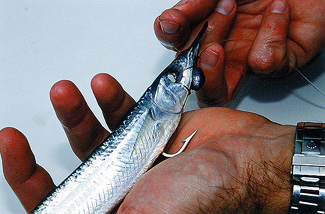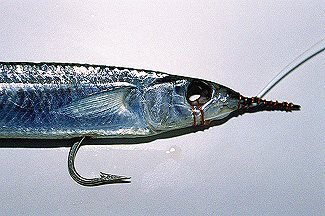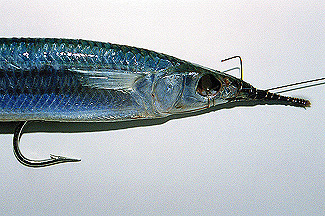Without a doubt, the most popular big game fishing bait of all time has to be the rigged ballyhoo. Millions are used each year to catch a wide variety of ocean game fish from marlin to king mackerel. There are many different ways to rig them, but there is certainly no one way or right way. The object is simple: get the bait to perform effectively for the fish you are targeting. Different species or different conditions can call for any one of a number of rigging styles. The bottom line is the satisfaction you get when you rig a bait correctly and catch the fish you're after, just like the many tournament winning captains and crews who do it day in and day out.
Most anglers with some experience with ballyhoo know the basic rigging techniques, but there is another favorite that is not as well known, but that can be particularly productive when conditions call for a slower speed or baits with a little more swimming action. It's called the split-bill ballyhoo. It's a sure fire way to get a ballyhoo to swim like it is alive and if you haven't used the method before, you will be amazed at how well it performs. When rigged properly, the split bill will act just like the lip on a swimming plug causing the bait to shimmy and stay well below the surface, even without a chin-weight.
A split-bill ballyhoo is a excellent billfish bait and white marlin sharpies have been using it for quite some time, but it can be used for just about any striking game fish. It's a good sailfish bait or you can add a stinger hook and have a great wahoo or kingfish bait. The rigging technique I'm about to explain and illustrate can be used with any size ballyhoo, from mediums to horses.
Bait Preparation
Preparing baits correctly will dramatically improve the quality of the finished product and how long they will last in the water. First start with top quality baits. They are the key to rigging beautiful, fishing catching baits and the preparation process actually starts at the time they are first caught. If the bait supplier takes the proper steps to insure the baits will be in prime condition when they are shipped, you're already half way home. Spending the extra few bucks to purchase high quality baits will save you from a dreadful day dragging rotten ballyhoo that come apart after a short time in the water.
Obtaining fresh ballyhoo is impossible in many areas where they are still a popular and effective bait. So, if you're purchasing frozen bait like most anglers, make sure the bags they are packaged in are clean and have no ice or blood inside them. The fish's eyes should look clear and their bellies should be pearly white. Be sure they don't have broken beaks or missing fins or scales.
When starting with frozen ballyhoo, there are a few things to do before the rigging process even begins.

First, thaw the bait in a brine solution of water, kosher salt and baking soda . The baking soda helps the baitfish retain its vibrant silver and white colors and kills any bacteria that can lead to deterioration. The kosher salt toughens the skin, which keeps the bait together longer on the line. Now remove the eyes by pushing a dowel or a small deboner through the eye sockets.
The next step is the most important. Flip the ballyhoo over in your hand and begin pinching the top of the ballyhoo with your thumb and forefinger starting from just behind the head and working back to the tail. As you pinch, feel the meat loosen from the backbone. When done correctly, the ballyhoo will become even more flexible once it's rigged and it will swim beautifully.

Last step is to remove the stomach contents and air bladder by making a half inch incision at the anal vent and milking the belly contents out the opening. This is done by holding the fish upside down in one hand and placing your other thumb just behind the head and running it down the belly using a moderate amount of pressure. Be sure to empty the belly contents completely. Then rinse the baits in your brine and they are ready to rig.
Now, we're going to learn three different methods of rigging split-bills to cover a variety of species and circumstances. Start by picking the size ballyhoo you want to use (small, medium, select or horse) and select the appropriate hooks and leader to compliment the bait.
Mono Split-Bill
The first rig is built on monofilament leader material of whatever pound test is needed for the target game fish. It can range from as light as 80-pound on up, within reason. Just remember, extremely heavy leader can dampen a bait's action. This rig is probably the most commonly used and is a breeze to assemble. It is a favorite for billfish, especially as a drop-back bait, because it will look very natural as it floats back to a fish in the trolling spread, unlike a weighted bait which frequently sinks too fast. This is also a versatile bait that can be positioned anywhere in the spread, but on windy days it helps to run it only on flat lines off transom clips. The clips keep the lines down, low to the water and out of the wind.

When making this rig for billfish, I like to use a 6/0 or 7/0 Mustad 9175 hook with a medium or small ballyhoo. This particular hook is a short-shank, extra strong model and is reasonably priced. Be sure to sharpen the hooks before rigging the bait because they are never sharp enough out of the box. For most situations where sailfish and white marlin are the target species, I use 80-pound test leader which can be tied or crimped to the hook. I prefer using crimps and slide the end of the rigging wire in the crimp with the leader being sure it goes all the way through the sleeve and sticks out the other end before I press it with a crimping tool. This creates a neat, slip-free connection and anchors the rigging wire. By the way, I prefer using 15-pound test monel wire for rigging because it is soft enough to wrap around the split-bill of the ballyhoo without breaking it. The monel can also be straightened out easily by pulling it over the backside of pliers without breaking it, so it can be used again and again when replacing baits on the rig. Note that the placement of the rigging wire on the rig is crucial, because the wire must go through the eye sockets of the ballyhoo tightly without pulling the hook out of center.

The next rig is the monofilament split-bill with chin weight. This is a great outrigger bait because it won't get blown around in the spread as much as the unweighted rig. It is rigged basically the same as above, except the placement of the rigging wire is in a different position due to the addition of the egg sinker chin weight. The rigging wire is switched back to the hook shank. To accomplish this, run the rigging wire through the eye of the hook, wrap it around the hook shank then back up through the eye. The simplest way to attach an egg sinker is to simply run the leader through the hook eye and the sinker, and crimp them together like in the picture. Assemble a selection of rigs with different size chin weights and experiment with them to see which size works best under the trolling conditions and with different-sized ballyhoo.

The last rig is the pin rig split-bill assembled on single-strand wire leader. This is a great all around rig when not targeting billfish because it catches just about anything and it provides the protection of wire for toothy fish like wahoo and kingfish. For this one, I like to use a needle-eye Mustad 3412 hook because it fits cleanly in a ballyhoo's gill plates without creating any bulge. It is a longer shank hook and works well with 30-pound class or lighter tackle. If heavier tackle is being used, the Mustad 3412C is the double strength version and is recommended.
Start the rig by passing the wire through the hook eye and making a haywire twist, but leave the tag end pointing up to act as a pin for attaching the bait. Attach the rigging wire to the eye of the haywire twist as pictured. The extra weight and the thinner diameter of the leader wire, when compared to monofilament, makes this bait track straighter and stay down with less tendency to surface. This bait runs particularly well in the flat line positions.
Attaching the Ballyhoo
After making a sufficient number of rigs, it's time to start arming them with baits. This step is actually very easy and with just a little practice, you can make every ballyhoo swim perfectly every time. All three versions on the split-bill rigs are armed in basically the same manner. For the purpose of simplicity, I will outline how to rig the chin-weighted version, then discuss the minute differences in rigging the other two versions.
First, clip off the ballyhoo's bill with wire cutters, leaving about an inch from the mouth.


Then split the remaining bill down the middle with a knife or your finger nail, but don't split the bill all the way to the mouth. Next, thread the hook point in between the gill plates and out the center of the belly. Take the rigging wire and go in between the gill plates and into the eye socket and out the side of the socket. Pull up firmly on the rigging wire to set the eye of the hook in the gill plates.


Position the chin weight between the gill plates and wrap the rigging wire two or three times through the eye sockets and around the gill plates, behind the chin weight. This holds the gills closed and forms a keel which will help the bait track straight. Pull the rigging wire to the front of the chin weight then around the chin weight and through the eye sockets again. Push the rigging wire straight up through the bottom of the ballyhoo's chin and through the hinge joint in the upper lip. Pull straight up on the wire to snug the chin weight , then wrap around the leader and mouth two or three times to hold the mouth closed. Next, pull the monofilament leader up into the split in the bill and wrap the rigging wire under your leader and around and down the bill just tight enough to close the split. Make sure the chin weight and hook are centered and the hook isn't pulling on the belly.


The monofilament rig is done in exactly the same manner, except a chin weight isn't used. The wire rig is the same except for the pin. Insert the pin up through the chin and upper lip, then wrap the rigging wire behind it twice, then down and around the bill, underneath the leader.


These rigs can be further customized for specific fishing situations, but overall, these are three excellent swimming ballyhoo rigs. One final word of caution. Split-bill rigging does not lend itself to using a lure over the nose of the bait like a Hawaiian Eye or a little Mold Craft chugger. A lure over the top of this rig will cause the ballyhoo to swim sideways because of the angle of the leader through the bill and will also defeat the purpose of the rig altogether.
Keep in mind, the split-bill trolls effectively at considerably slower speeds than straight-rigged ballyhoo and lends itself to situations where dropping the speed and adding more action attracts more hits. Add it to your repertoire and see if it doesn't increase your trolling success. If you've got any questions, give us a call at Baitmasters, 800.639.2248, and we'll do our best to help.


 25% Off Unrigged
25% Off Unrigged Long Sleeve Dry Fit
Long Sleeve Dry Fit